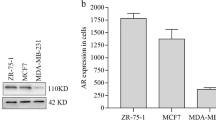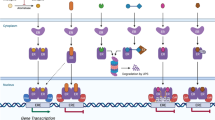Abstract
The concentration of cellular oestrogen receptor (RE) was measured in both the soluble and nuclear-pellet fractions of biopsies from 1,000 breast cancers. Data suggest that functional steroid RE is always in equilibrium between the soluble and nuclear fractions. However, biopsies from only one-third of patients contained detectable amounts of high-affinity RE in both fractions. Thirty patients out of 42 (71%) whose biopsies contained RE in both fractions, showed objective remission after receiving some form of hormonal manipulation as sole treatment. Response rates in the other categories ranged from 9% for those whose biopsies contained no detectable RE to 24% for those who displayed soluble RE alone. The presence of RE in both fractions of primary disease, whereas RE-negativity was maintained during progression from primary to secondary disease. Other aspects of RE status in relation to stage of disease are analysed.
This is a preview of subscription content, access via your institution
Access options
Subscribe to this journal
Receive 24 print issues and online access
$259.00 per year
only $10.79 per issue
Buy this article
- Purchase on Springer Link
- Instant access to full article PDF
Prices may be subject to local taxes which are calculated during checkout
Similar content being viewed by others
Rights and permissions
About this article
Cite this article
Leake, R., Laing, L., Calman, K. et al. Oestrogen-receptor status and endocrine therapy of breast cancer: response rates and status stability. Br J Cancer 43, 59–66 (1981). https://doi.org/10.1038/bjc.1981.8
Issue Date:
DOI: https://doi.org/10.1038/bjc.1981.8
This article is cited by
-
Investigation of the origin of variant, truncated estrogen receptor-like mRNAs identified in some human breast cancer biopsy samples
Breast Cancer Research and Treatment (1993)
-
Soluble and nuclear type I and II androgen-binding sites in benign hyperplasia and cancer of the human prostate
Urological Research (1992)
-
Nuclear binding of the estrogen receptor: A potential predictor for hormone response in metastatic breast cancer
Breast Cancer Research and Treatment (1990)
-
Chemotherapy of breast cancer
Medical Oncology and Tumor Pharmacotherapy (1984)
-
The effect of molybdate on the intracellular distribution of estrogen receptor in mammary tumors
Breast Cancer Research and Treatment (1984)



